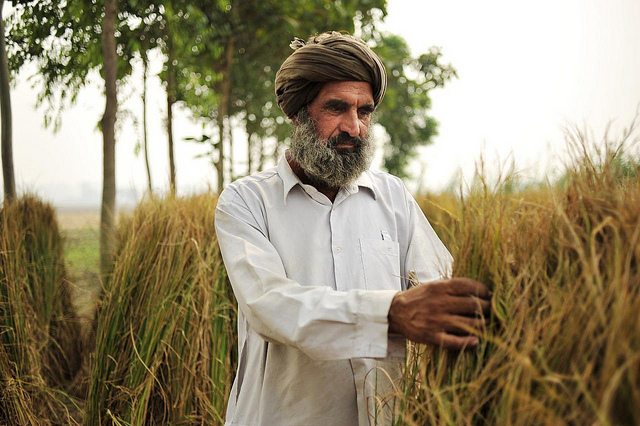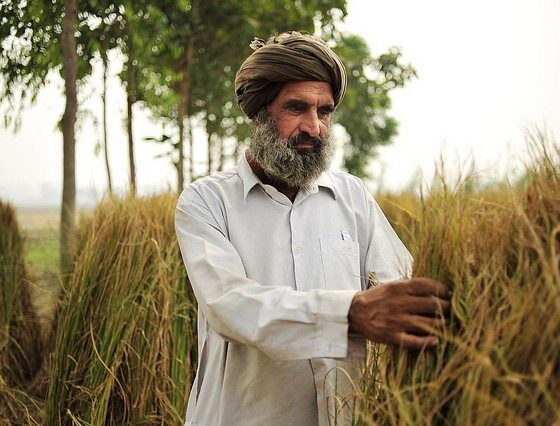

Environment
Lunch in the sunshine – the relationship between agriculture and climate change
Ed Bailey, assistant fund manager for the Sarasin Food and Agriculture Opportunities Fund, explores some of the innovations, adaptations and policies that will drive sustainable production growth in the agriculture sector.
Blue & Green Tomorrow is currently running a crowdfunder to ensure its survival. Please pledge.
Food and agriculture is a key focal point of the climate change debate – climate change will impact agricultural production but agriculture itself is a major climate change contributor. The industry must continue to adapt to, and mitigate, this challenge.
Climate change villain…
The Intergovernmental Panel on Climate Change (IPCC) estimates that food production contributes over 25% of man-made CO2 equivalent emissions. The bulk of this is generated by nitrogen fertiliser production, deforestation and livestock production, though mechanisation and soil turnover are also contributors.
Nitrogen fertiliser: a revolutionary problem. Nitrogen fertiliser is produced by converting atmospheric nitrogen (through reaction with natural gas) to ammonia, which can then be further processed into urea or other applicable compounds. While this process has revolutionised agriculture, and is estimated to be responsible for sustaining a third of the world’s population, a proportion of the fertiliser reacts with oxygen when applied to a field, forming the greenhouse gas (GHG) nitrous oxide. This GHG has a global warming potential 296 times larger than an equal mass of carbon dioxide.
In the developed world, new formulations of nitrogen fertiliser by companies like Yara and more efficient application through precision farming have already done much to reduce the scale of emissions from nitrous oxide, but there is still considerable scope to reduce the wide use of basic urea and ammonia formulations in emerging market agriculture. It is estimated that a 20-30% reduction in nitrogen fertiliser use in China would save GHG emissions equivalent to Indonesia’s entire power sector.
Deforestation: regulation and industry awareness
Deforestation is often driven by farmers clearing land for pasture or crops. The spread of cattle farming into the Amazon, and the clearing of primary forest in Asia for the production of palm oil (increasingly used in process foods), are perhaps two of the most infamous examples; tropical deforestation is thought to release 1.5 billion tons of carbon each year.
National and international regulations and codes of best practice have been implemented across the world to stop further deforestation, and a number of companies have now committed to sourcing only products certified as sustainable by agencies such as the Roundtable on Sustainable Palm Oil (RSPO). Most large palm oil producers, for example, have now committed to processing only oil produced on sustainably managed land, and many palm oil users are similarly committed to a sustainable product.
Livestock: a meaty challenge
Livestock production is the most significant agricultural GHG emitter, producing 18% of total GHG emissions when land-use change including deforestation and feed production is taken into account. What’s more, emerging market diet change is driving increased demand for protein and livestock production will grow to fill this need. Some innovation is being made in cutting emissions through the use of enzyme based feed additives produced by Novozymes and through breeding animals that emit less methane (Genus) but the livestock industry will continue to be a major GHG emitter.
As such, we expect to see further government policies to regulate and reduce agricultural emissions from these key areas, but the bulk of the future reduction must come from emerging markets where progress lags developed agricultural economies. With emerging market governments reluctant to burden farmers and threaten food security, we see ongoing advantages for those companies finding new ways to provide low cost solutions to these challenges.
Climate change victim…
Agricultural production is highly dependent on localised weather conditions throughout the year, and different crops are suited to a range of climatic conditions. Palm oil, for example, can only be produced in a small tropical band within 20 degrees of the equator, while grains like wheat and corn require a more temperate climate.
Climate change will not affect all regions equally, creating a mixed impact of climate change on agricultural production. An in depth study conducted by the IPCC has concluded that the ideal range for grain production would slowly move North, and that farmers are already adapting to this through altering cultivation and sowing times and crop cultivars. Less work has been done on the impact on tropical crops, but it is possible that more humid conditions near the equator would have a net positive impact on the yields of palm oil and cocoa.
Short term weather extremes are considered a larger threat to annual production than long term climate trends. Over the past two decades, there has been a recordable increase in droughts, floods, heat waves and freezes. While these tend to have localised impacts, weather extremes in the major crop growing regions of the US, Brazil, Eastern Europe or China can send price shocks through the wider food and agriculture markets. While global grain stocks are recovering from record lows, a major disruption in agricultural production would once again strain supplies and food prices would again rise.
Evolution and adaption throughout the food and agricultural industry
Farmers are adapting their planting timings and crop rotations to adjust to the gradual warming of the climate, while also increasing the area of cropland under irrigation. New cultivars (including genetically modified crops) offer some protection against environmental stress and farmers are increasingly focused on improving soil quality. Those companies able to provide the innovation and infrastructure in seeds and inputs (Syngenta), equipment (Agco) and grain handling (Archer Daniels Midland) to facilitate this adaption are the likely beneficiaries of this trend.
At the consumption end of the food and agriculture value chain, leading food processors and retailers like China Mengniu Dairy and Barry Callebaut (chocolate) are also looking at ways to improve the security of their raw material supply. By diversifying sourcing, working with and supporting farmers and reducing waste, companies can reduce the impact of short-term price shocks and longer-term food price inflation.
Our response: engage and evolve
Climate change has the potential to alter the food and agricultural landscape significantly through the introduction of new policies aimed at reducing emissions, the adaption of farming practices and inputs and a greater focus on sustainable sourcing from food processors and retailers.
At Sarasin & Partners we believe that the best way to tackle these changes is through discussion with policy-makers, engagement with companies, and consideration of the impact of climate change on our investee companies. In this way, we are able to identify and monitor those companies driving and adapting to the new reality, and – we hope – those most likely to benefit.
Ed Bailey is the assistant fund manager for the Sarasin Food and Agriculture Opportunities Fund. He joined Sarasin to provide research overage of food and agriculture in 2008 and assumed fund management responsibilities in 2012.
Photo: CIAT via Flickr
Further reading:
Role of agriculture in sustainable development to be debated
Stronger sustainable productivity needed to boost African agriculture, leaders say
World must cut meat consumption to prevent climate change and food insecurity
Climate change will trigger global food crisis, says World Bank official
Investment fund launched to support sustainable innovation in farming


 Environment10 months ago
Environment10 months agoAre Polymer Banknotes: an Eco-Friendly Trend or a Groundswell?

 Environment12 months ago
Environment12 months agoEco-Friendly Home Improvements: Top 7 Upgrades for 2025

 Features9 months ago
Features9 months agoEco-Friendly Cryptocurrencies: Sustainable Investment Choices

 Features10 months ago
Features10 months agoEco-Friendly Crypto Traders Must Find the Right Exchange





























